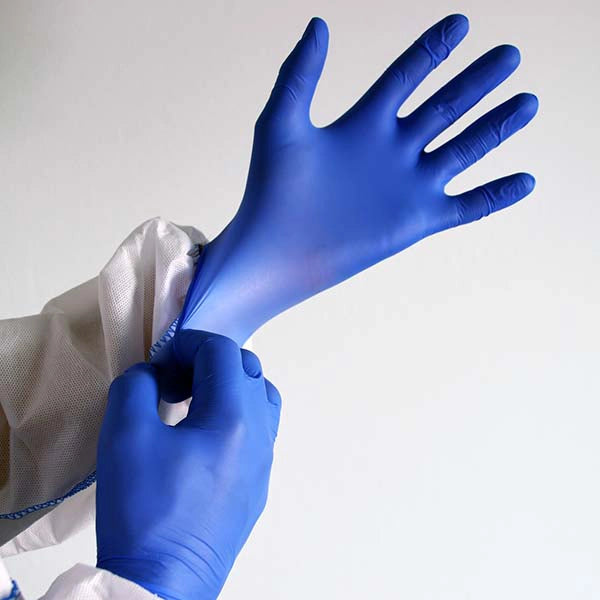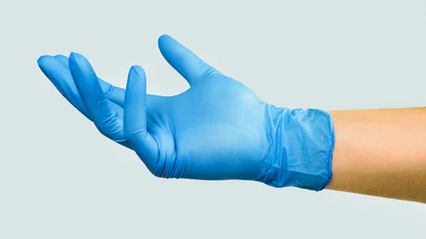As a sanitary tool, disposable gloves are the best friend of essential workers. Any job that routinely confronts bacteria, biohazards, harsh chemicals, or other potentially harmful substances relies on disposable gloves as their foremost ally in protecting the health of their workers.
But first, you have to find the right gloves for the job.
This is often the choice of material, and there are a lot of options out there, from natural rubber to synthetic rubber to latex to nitrile to vinyl. Here’s a look at common glove materials, the benefits of each, and when each material is the right choice for your team.
When to Use Disposable Gloves
Workers across the country rely on disposable gloves for puncture-resistant, durable sanitary protection. Any time your hands need protection without the worry of contamination, you need a disposable glove.
For example, medical workers are among the most common users of disposable gloves. But tattoo artists also rely on single-use gloves to protect their hands and protect their client’s new tattoo from infection while they create their art. Industrial workers count on disposable gloves to keep their hands safe and healthy. Lab workers use gloves to prevent contaminating any samples. Even industrial workers count on gloves to protect their hands.
However, each of these workers has different needs from a glove, and that often comes down to the choice of glove materials.
Types of Disposable Glove Materials
In general, there are three main types of disposable gloves:
- Nitrile
- Latex
- Vinyl
Technically, you could use any of these gloves in any situation. However, not every material is suitable for all applications.
Advantages and Disadvantages of Materials
Based on the material in question, the glove may be more or less puncture-resistant and durable. Conversely, the material may be easier or harder to remove. Some gloves are allergen-friendly, while others aren’t. Plus, every industry has its own unique standards for gloves.
In short, there is no universal glove material. Some gloves, like natural rubber or synthetic rubber, are great for basic cleaning tasks. Some gloves meet the exacting standards of exam-grade medical gloves. Some gloves can handle the wear and tear of heavy industrial work.
Here’s what you get from each of the three main glove materials.
Nitrile Gloves
Out of all the disposable gloves on the market, nitrile gloves are the most popular. It’s created using synthetic rubber called acrylonitrile-butadiene, which means the material is latex-free and allergen-friendly.
They’re popular among a variety of industries because they’re highly chemical resistant while still allowing tactile sensitivity. They’re especially resistant to oils and acids, making them a great choice for lab research and food prep. And since they’re strong, durable, and puncture resistant, they’re a popular option for medical professionals worried about working with sharps.
The one major downside of nitrile is that it’s not as flexible as some other glove materials. This makes it less ideal for frequent application and removal and should instead be worn if you have to keep the glove on for a while.
Latex Gloves
Latex gloves have long been a standard of the medical industry.
Surgeons in particular like latex gloves because they work well with water-based and biological agents. Plus, they offer flexibility that’s hard to beat, which is important for people who have to do precise work while wearing protective gloves.
Oh, and for those thinking about the environment, latex gives you a bit of forgiveness. Natural latex is biodegradable--not very fast (six months to four years)--but it’s biodegradable. However, synthetic and treated latex is not biodegradable.
The biggest downside, of course, is that they’re not allergen friendly, even if they’re also powder-free. If you’re ever worried about latex allergies, these gloves are off the table. They also don’t hold up very well against chemicals and solvents.
Vinyl Gloves
For those who need frequent glove changes, vinyl gloves are a great option. They’re among the most economical gloves on the disposable glove market. Like nitrile gloves, they’re latex-free, so a powder-free vinyl glove gives you an allergen-friendly option.
The biggest downside of vinyl is that it tends to fit more loosely than latex or nitrile gloves, which makes it uncomfortable to wear for extended periods of time. That’s part of why vinyl gloves are intended for high-volume projects requiring frequent glove changes.
Vinyl gloves also tend to be less durable, so they’re not the right choice for heavy duty applications or industrial work. They don’t hold up well to harsh chemicals or biohazards, either, so they aren’t the right choice for industrial work or medical settings.
Latex, Nitrile, or Vinyl--Which is Right for You?
Which is the right glove material for you? It depends on what you’re looking for in a glove and what you intend to use the glove for. Start by thinking about the job in question and what specific qualities your workers need for that application. From there, you can start shopping around.
Here’s what each of the three materials are good for--and what they’re not good for.
Best Applications for Nitrile Gloves
For those who need extreme protection, nitrile gloves are your best bet. These are hardy gloves, and since they’re made of rubber, you don’t have to worry about allergic skin reactions.
Thick nitrile gloves are a great choice for industrial work, since this is one of the most durable materials you can find.
Regular thickness nitrile gloves are frequently used in medical examinations, laboratory work, and janitorial work, since they offer excellent resistance to biological hazards and harsh chemicals.
These gloves are great for:
- Mechanics
- Medical professionals
- Food prep workers
- Lab workers
They should not be used for electrical work. For those who need chemical resistance, check the rating on the specific glove.
Best Applications for Latex Gloves
Latex gloves remain quite popular among medical professionals, since their flexibility and resistance to biohazards is hard to beat. Plus, because you get excellent tactile sensitivity, it’s a great choice for those who need precision. They’re popular among surgeons for that reason.
These gloves are great for:
- Medical professionals
- Beauty and salon workers
If your office plans to use latex gloves, you should always check for latex allergies. If you work with patients, always ask the patient if they have latex allergies and keep a supply of non-latex gloves on hand for easy access.
These are not the right choice for workers who need puncture resistance or those worried about chemicals.
Best Applications for Vinyl Gloves
Vinyl gloves are cheap to produce and easy to take on and off. However, the material fits more loosely than most nitrile or latex options, so it’s not the right choice for precision work. Plus, they’re not the most durable option (for heavy physical work or work with chemicals).
For this reason, vinyl gloves are the right choice for low-risk, high-volume jobs that just need a basic layer of sanitary protection, such as:
- Food prep
- Light cleaning
- Work with non-hazardous materials
Keep in mind that vinyl gloves don’t offer great chemical protection, so if you’re using them for janitorial work, use them for light cleaning only.
Find the Perfect Glove Material No Matter the Task at Hand
No matter the task at hand, our collection of disposable gloves gives you the perfect fit to get the job done right. Plus, we carry high-quality nitrile, latex, and vinyl gloves, all rigorously tested and trusted by industry leaders like Johns Hopkins Hospital.
Ready for gloves your team can count on? Check out our collection today.



